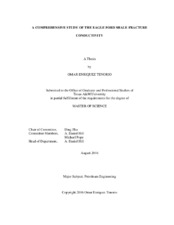| dc.description.abstract | The aim of this study was to develop an understanding of the Eagle Ford shale unpropped and propped fracture conductivity. Samples were collected at Antonio Creek and Lozier Canyon. Both outcrops are several hundred feet thick and extend for a few thousand feet laterally. At these locations five different geological facies (A, B, C, D and E), each with distinct lithological characteristics and geochemical properties that can be correlated to the Eagle Ford shale in the subsurface are accessible. The mineralogy of the collected samples was determined via x-ray diffraction which corroborates the relationship of the samples to the outcrops and hence to the Eagle Ford shale in the subsurface.
After collected, the samples were cut into modify API conductivity cell dimensions. The fracture conductivity at different closure stresses was determined based on laboratory measurements of flow rate and pressure drops along the fracture. The fluid used in this work was nitrogen. The proppant concentration used is representative of what is commonly used in hydraulic fracturing treatments in the Eagle Ford shale. The heterogeneity of the Eagle Ford shale is addressed by obtaining conductivity samples in two different directions with respect to the bedding plane for the five geological facies. Three directions were obtained for facies B.
Fracture area and fracture roughness (surface attributes) were calculated from the data taken by a surface profilometer. The mechanical properties, namely Young’s modulus, Poisson’s ratio and Brinell hardness, were experimentally determined from core plugs acquired from the same rocks where the conductivity samples were obtained. The effect that the surfaces attributes, mechanical properties and geological facies (mineralogy) have on conductivity was analyzed and the major findings of this work are the following.
From this study, we found that fracture orientation has an impact on the fracture conductivity. It was also found that the geological characteristics (mineralogy) and mechanical properties (Poisson’s Ratio) impact the fracture conductivity. The geological facies (lithology) impact the fracture conductivity in Eagle Ford shale. Facies A, B and C exhibit a good relationship between fracture conductivity and surface attributes (fracture roughness and area). This relationship is not present in facies D and E.
This work provides a foundation for future studies (damage mechanism) of the Eagle Ford shale fracture conductivity and gives an insight into the relationship of fracture conductivity and geological facies. | en |


